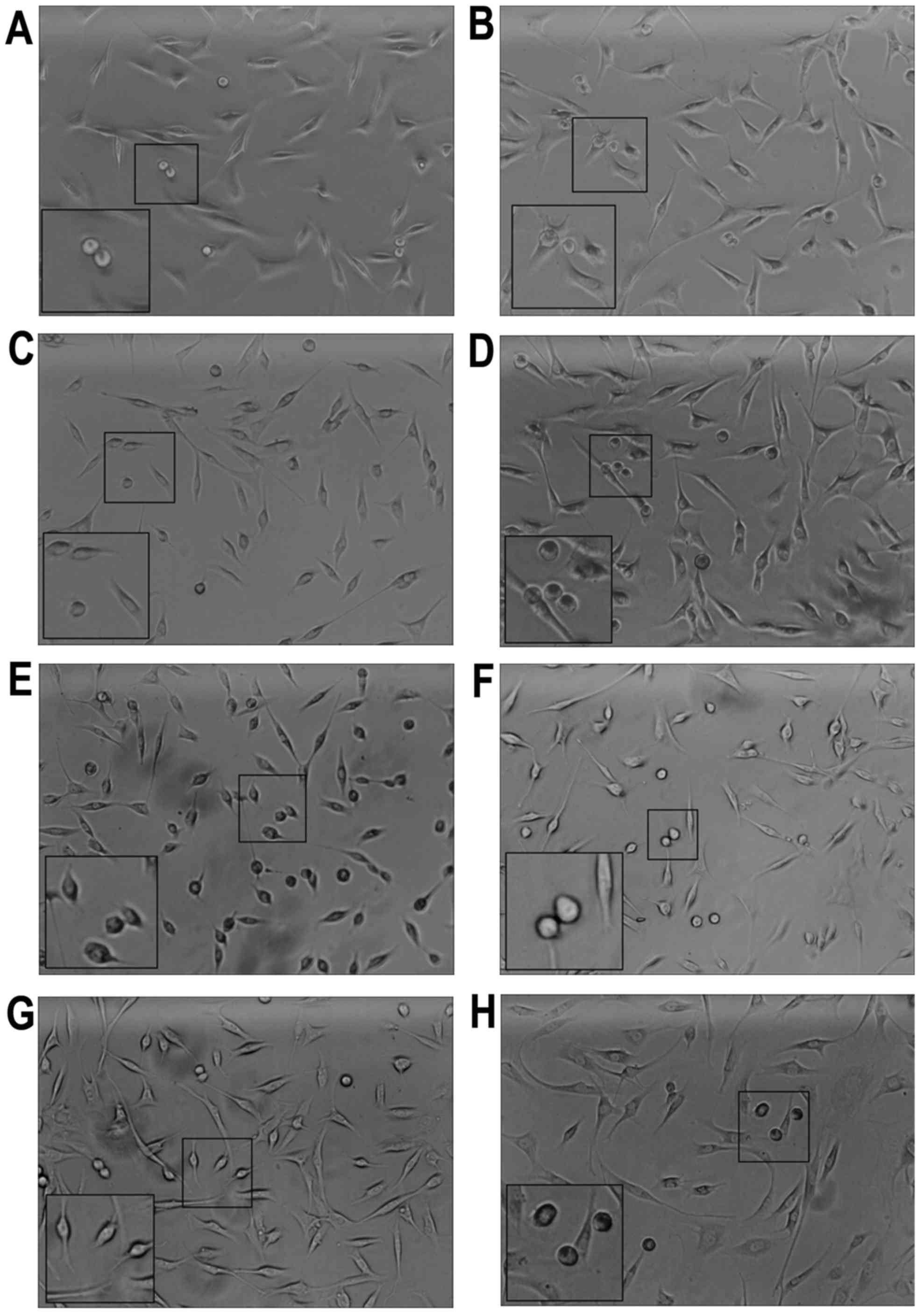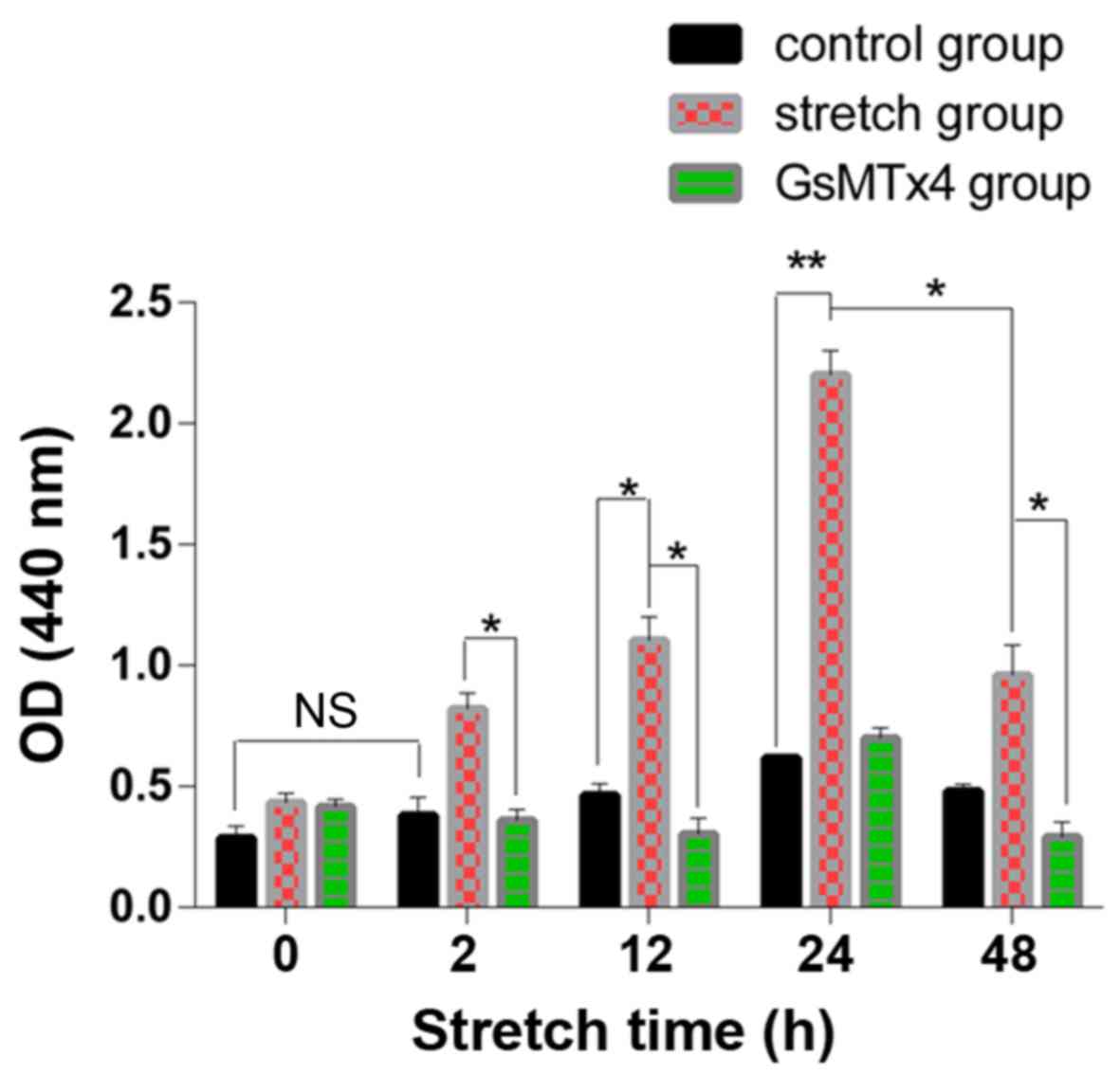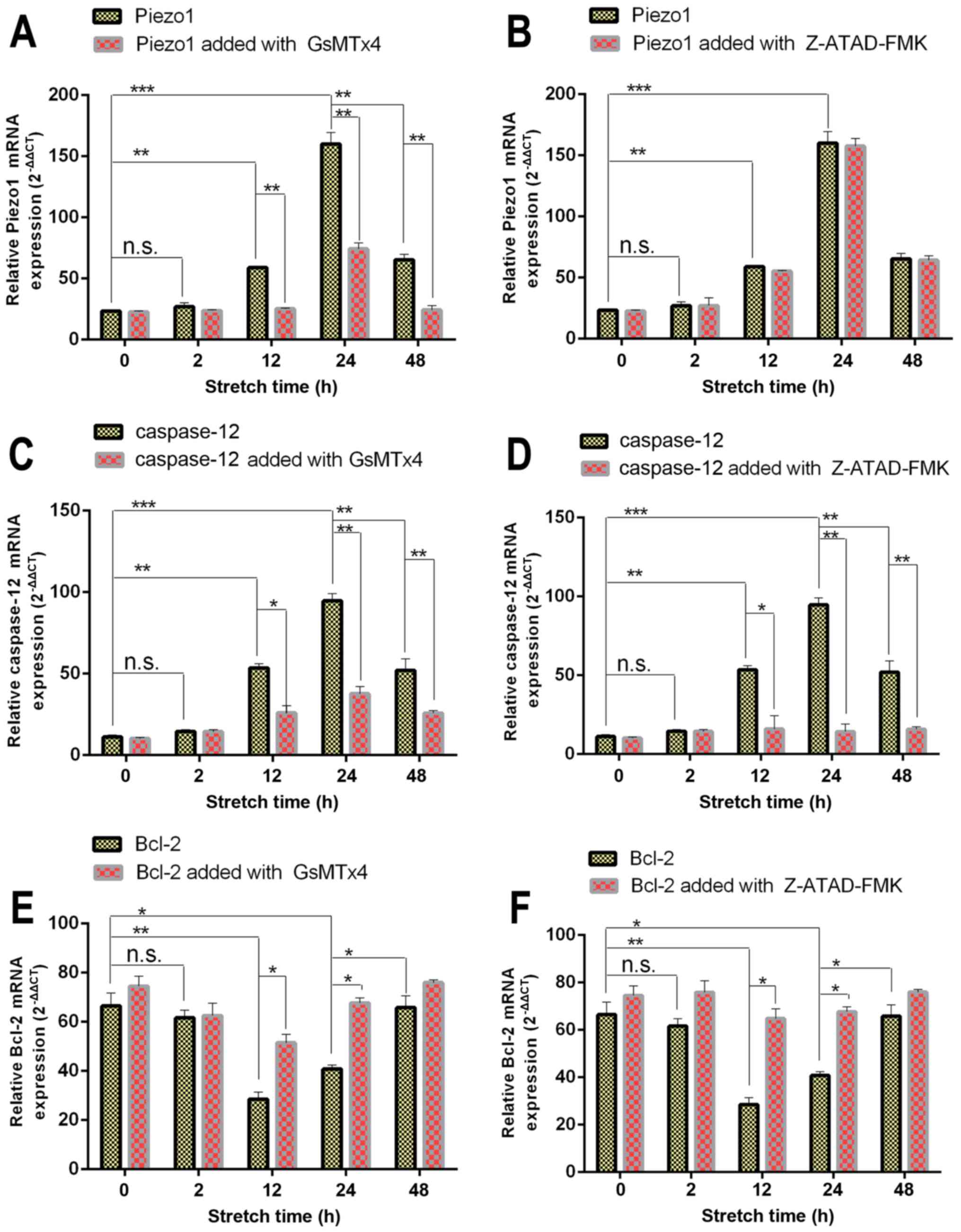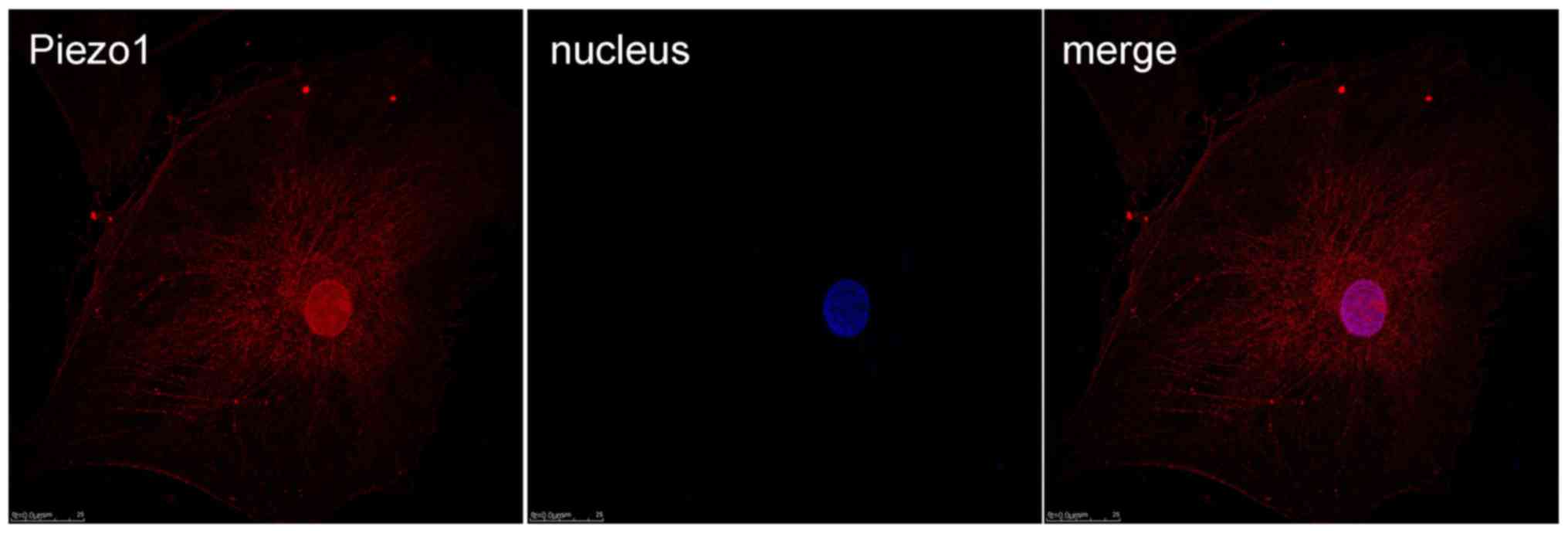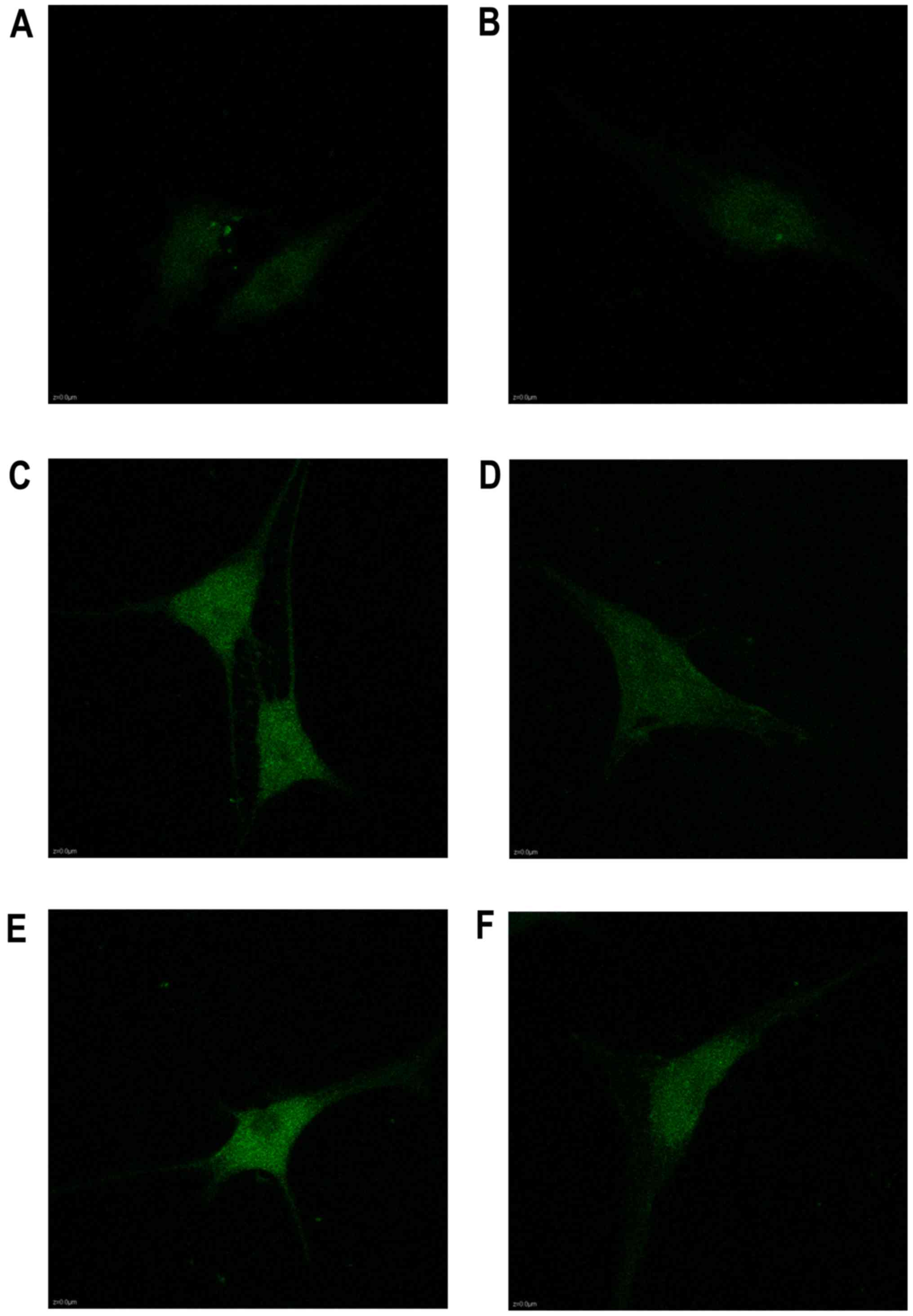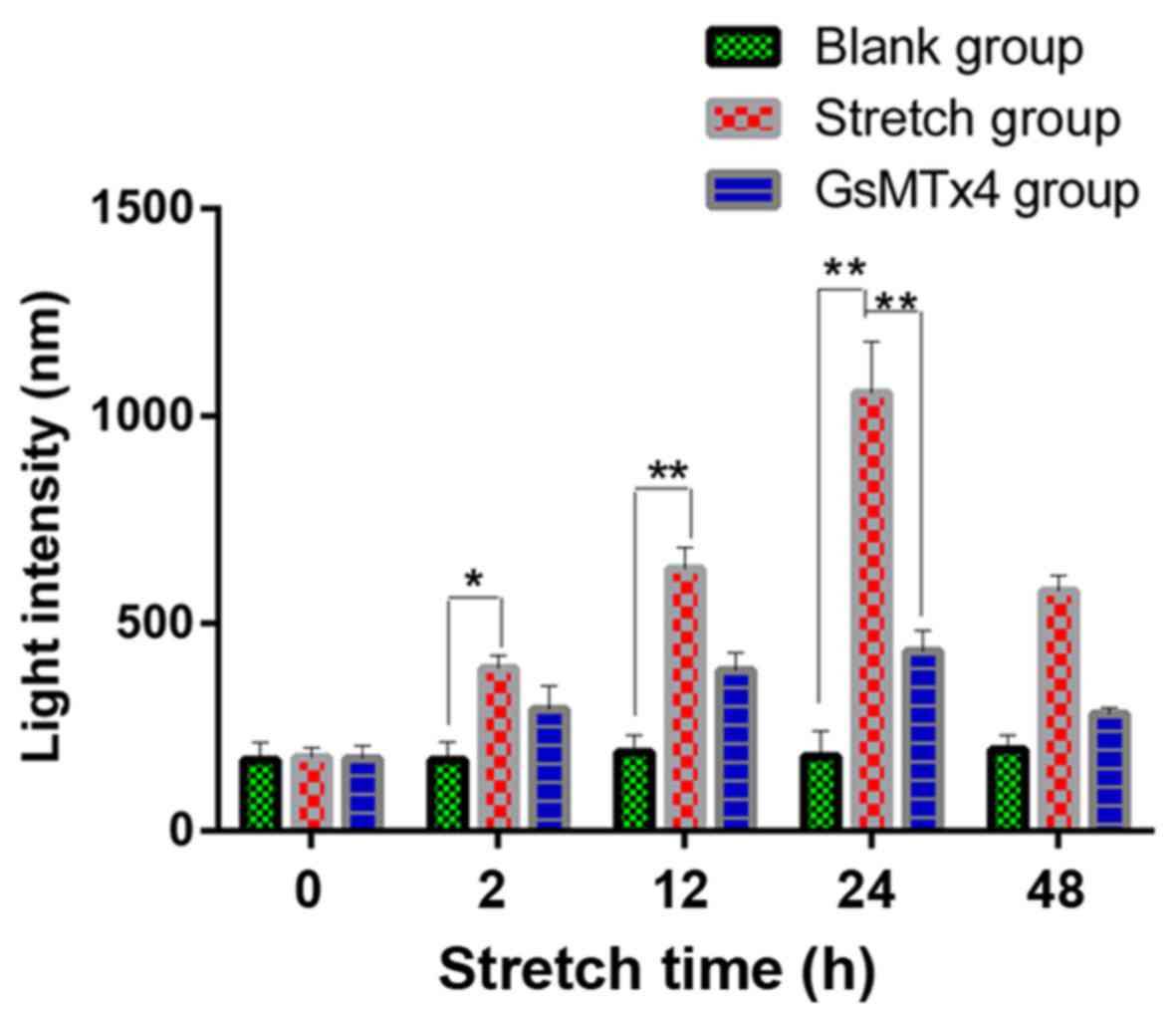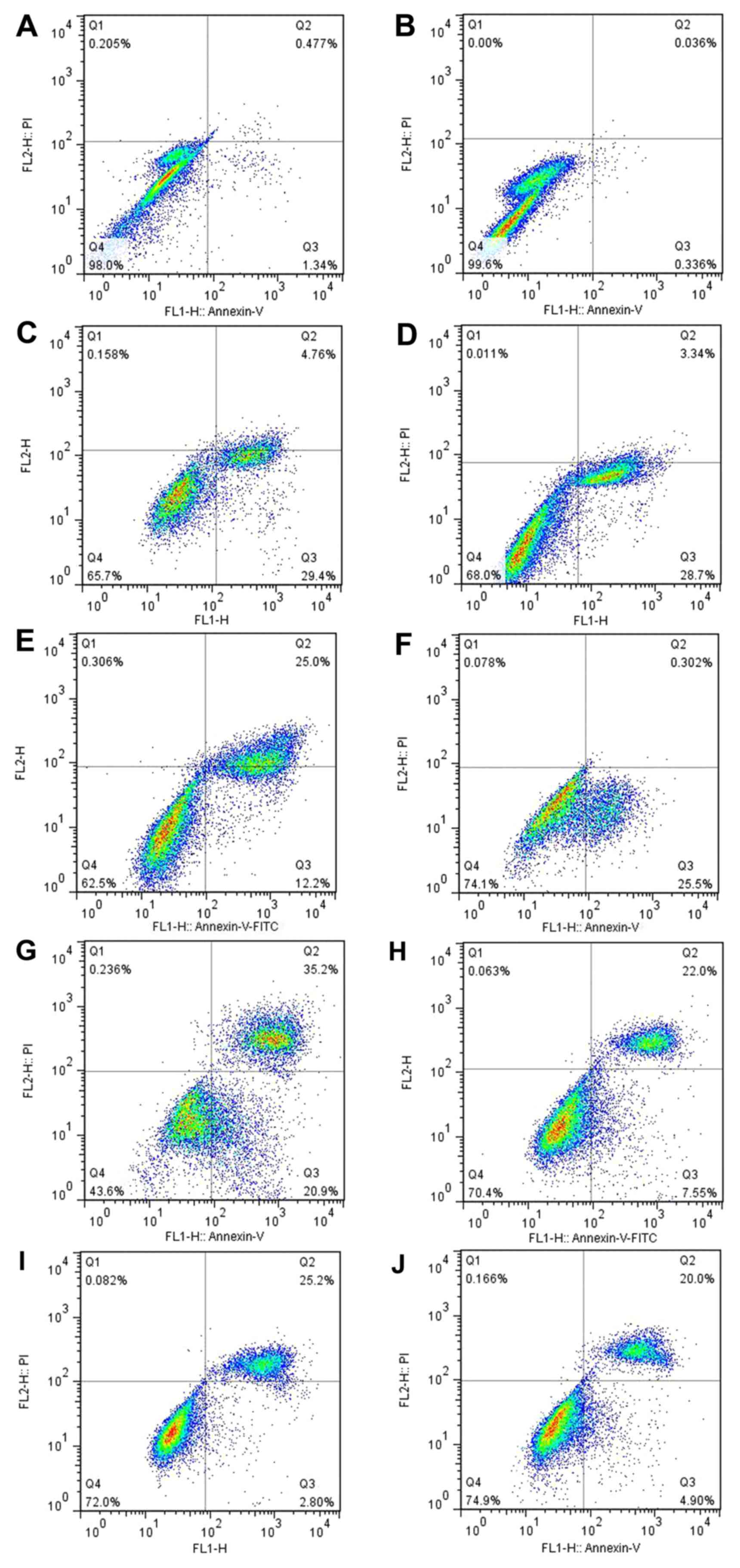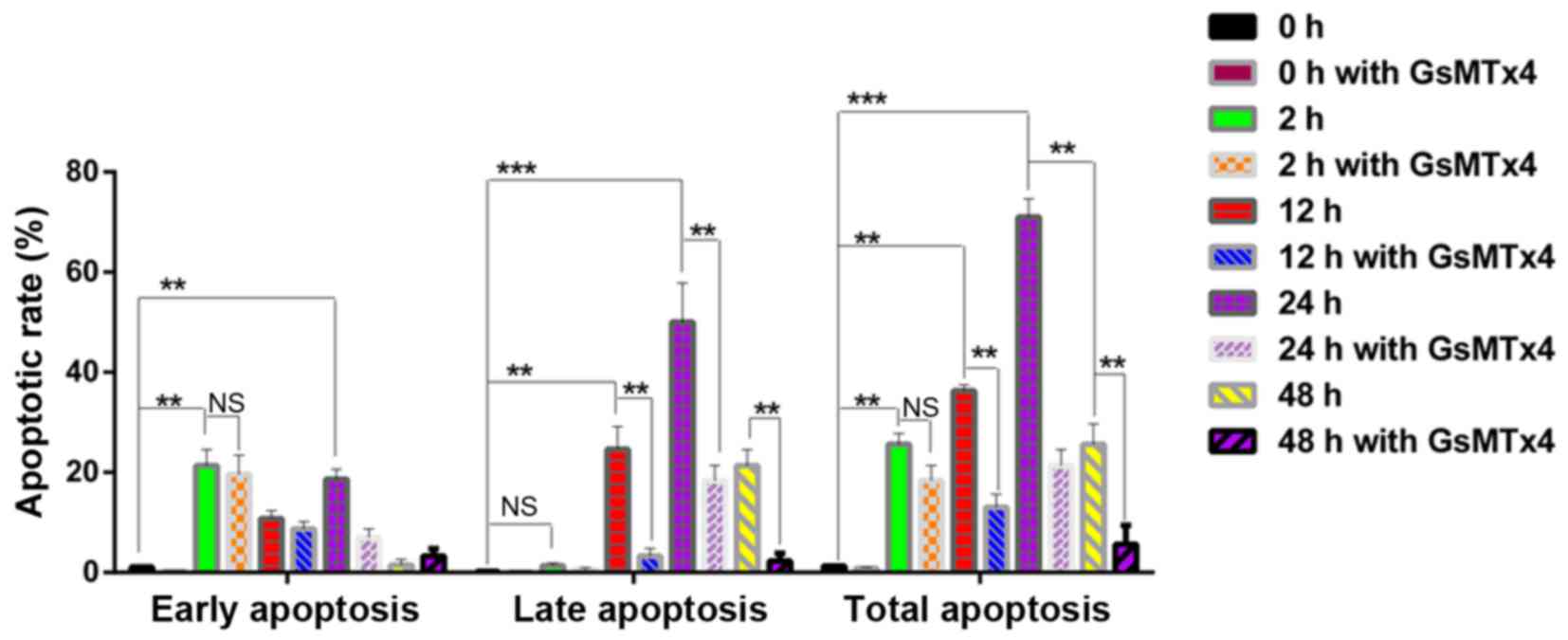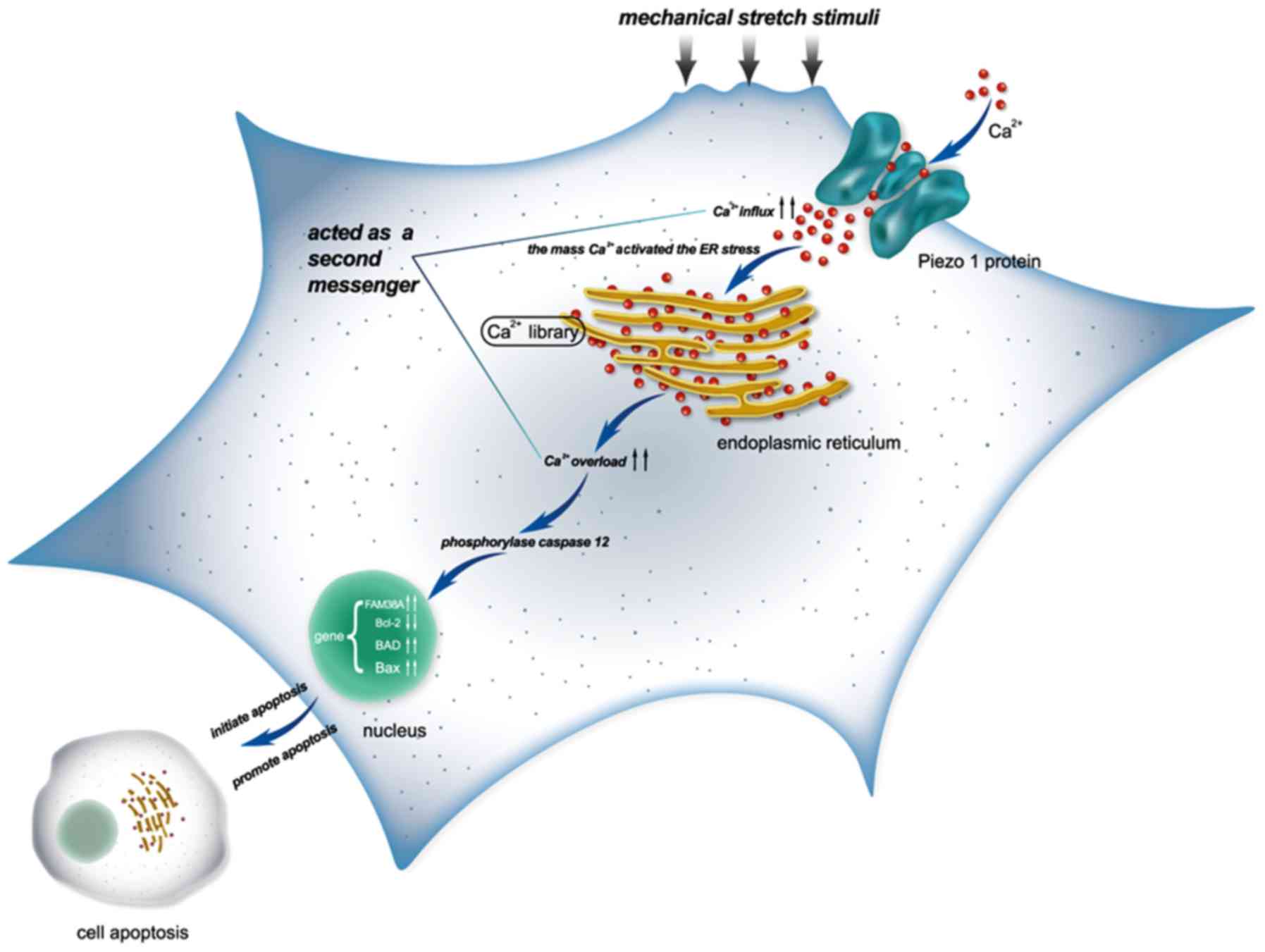Piezo1 protein induces the apoptosis of human osteoarthritis-derived chondrocytes by activating caspase-12, the signaling marker of ER stress
Retraction in: /10.3892/ijmm.2018.3918
- Authors:
- Published online on: July 19, 2017 https://doi.org/10.3892/ijmm.2017.3075
- Pages: 845-853
-
Copyright: © Li et al. This is an open access article distributed under the terms of Creative Commons Attribution License.
Abstract
Introduction
Chondrocytes, cells in articular cartilage, can support mechanical loads and regulate their metabolic activities in response to mechanical loading. Chondrocytes are the only cells in cartilage and are responsible for maintaining and modeling cartilage through a homeostatic balance of anabolic and catabolic activities (1). Under abnormal loading conditions, such as obesity, trauma, or joint instability, mechanical factors play a critical role in the onset and progression of osteoarthritis (OA) (2). However, the mechanisms determining how OA-derived chondrocytes sense and transduce mechanical signals inducing their apoptosis remain unclear.
Recently, a novel mechanically activated (MA) cation channel named 'Piezo' was identified by Coste et al (3,4), which is an evolutionarily conserved ion channel family of cation-permeable proteins involved in mechano-transduction. In Drosophila, the dPiezo protein was found to be a mechano-transducer in mechanical nociception (5). The hPiezo protein has also been reported to be a key player in cellular response to mechanical stimuli in human erythrocyte membranes and bladder urothelium, and the mutation of the hPiezo protein was found to be related to human anemia, hereditary xerocytosis and distal arthrogryposis type 5 (6–12). hPiezo1 and hPiezo2 were identified as proteins involved in mechanosensation ion channels which have the ability to sense mechanical signals and maintain cell volume homeostasis. Studies have also shown that mechanical stimuli such as fluid shear stress, which causes lower expression of Bcl-2, leads to the apoptosis of OA-derived chondrocytes (13–15). Chondrocytes are mechanosensation cells, thus Piezo1 may play an important role in the apoptosis of human OA-derived chondrocytes.
The endoplasmic reticulum (ER) is one type of organelle which plays an essential role in multiple cellular processes that are required for cell adaptation, apoptosis, and other cellular functions (16). Notwithstanding, ER stress-induced apoptosis of OA-derived chondrocytes in patients with OA still remains incompletely understood. Caspases are cysteinyl aspartate-specific proteases that play a pivotal role not only in the inflammatory responses against microbial infection but also in the induction of apoptotic cell death. During these processes, caspase-12 can dampen the responses to bacterial infection, inhibit IL-1 and trigger pyroptosis. However, evidence is limited to prove that caspase-12 can induce the apoptosis of OA-derived chondrocytes in OA patients by mechanic stress.
B cell lymphoma/leukemia-2 (Bcl-2), Bcl-associated X protein (Bax) and Bcl-2-associated death promoter (BAD) serve as the apoptosis cascade, which is closely related to the apoptosis of cells (17–21). Bcl-2 is an anti-apoptosis signaling factor, which promotes cell proliferation and inhibits apoptosis through many complex pathways (17). However, BAD is an important apopotosis factor, whose homology with Bcl-2 is restricted by BH1 and BH2 domains (21). BAD can be activated by Bcl-xL leading to cell apoptosis by suppressing the Bcl-2 family, which acts in the function of Bax. In this study, the expression levels of Bcl-2, Bax and BAD were detected by reverse transcription-quantitative polymerase chain reaction (RT-qPCR), in order to explore the connection between mechanical stress-induced apoptosis and the Piezo1 protein.
Materials and methods
OA-derived chondrocyte culture
Human articular cartilage tissue was isolated from the knee of 20 patients suffering from OA (mean age, 40±12.5 years; 12 females and 8 males) during total knee arthroplasty from October, 2014 to December, 2015, without infections or blood diseases. The study protocol was approved by the Ethics Committee of the Affiliated Hospital of Qingdao University, China. All patients provided informed consent according to the 2013 Helsinki Declaration (22). Osteochondral specimens were harvested from the femoral trochlea without macroscopical fibrillation, briefly washed in phosphate-buffered saline (PBS), mixed with 400 U/ml penicillin and 0.4 mg/ml streptomycin under aseptic condition and cut into small pieces (1×1×1 mm3). Then the specimens were added to 0.25% pancreatic enzymes and 0.2% collagenase II for 30 min and 4 h respectively. After that, the appropriate 10% α-minimum essential medium (α-MEM) was added to the mixture. Trypan blue staining was used to detect the viability of the OA-derived chondrocytes. The OA-derived chondrocytes were plated in 50 cm2 cell culture flasks (Nunc, Roskilde, Denmark) at a density of 5×104/cm2 containing human OA-derived chondrocyte culture media comprised of α-MEM supplemented with 12% fetal bovine serum (FBS) (both from Hyclone, Logan, UT, USA) and 1% penicillin-streptomycin (P/S) (Invitrogen, Carlsbad, CA, USA). The cells were cultured at 37°C with 5% CO2, and the medium was changed twice a week. When the cells reached 70–80% confluency, the adherent OA-derived chondrocytes were harvested using 0.25% Trypsin-EDTA (HyClone), at 37°C for 3 min. Following passages, the cells were plated (1×106 cells/185 cm2) in Nunclon Delta Solo flasks (Sigma-Aldrich, Darmstadt, Germany).
Viability of the OA-derived chondrocytes
The mixture containing 0.04% trypan blue in final concentration was added to the cells, and was observed under a light microscope. The viability of the OA-derived chondrocytes was calculated based on the formula: Viability (%) = living cells/(living cells + dead cells) ×100%.
Application of cyclic stretch
The primary OA-derived chondrocytes were seeded in growth medium [(GM) containing 15% heat-inactivated FBS; 100 U/ml of penicillin and 100 μg/ml streptomycin (Pen Strep); as well as L-glutamine (all from Life Technologies, Carlsbad, CA, USA)] at 3×106 cells/well on 6-well collagen-coated BioFlex plates containing a flexible silicone elastomer substratum and grown to 80% confluence under non-stretch conditions for 3–5 days. BioFlex plates were then mounted in a Flexercell Strain Unit (both from Flexercell International, McKeesport, PA, USA) and subjected to 20% surface elongation at a frequency of 6 cycles/min, each cycle consisting of a 3-sec stretch alternating with 3 sec of relaxation with a computer-controlled vacuum stretch apparatus (FX-4000T Tension Plus System; Flexcell International). Cells were harvested after 2, 12, 24 and 48 h, respectively. Control cells (0%) were cultured on similar plates and kept in the same incubator without mechanical strain.
Analysis of dead cells
The lactate dehydrogenase (LDH) detection kit (Roche Diagnostics, Indianapolis, IN, USA) was used to monitor the activity of LDH in the OA-derived chondrocytes after 2, 12 and 48 h. One hundred microliters of the medium was discarded from each well, and then 50 μl of 2% Triton X-100 solution was added to lyse the cells. The samples were incubated in the dark for 30 min at room temperature, and then were detected by fluorescence (490 nm) using a BioTek spectrofluorometer plate reader with KC4 analysis software (BioTek, Winooski, VT, USA).
RT-qPCR
Total RNAs were extracted with RNAiso kit (Takara, Tokyo, Japan) after 2, 12, 24 and 48 h of compressive stress, respectively. The concentration and purity of the total RNA were evaluated with a spectrophotometer. RT-qPCR was performed and analyzed to assess the expression of Piezo1 and caspase-12, using the SYBR Premix Ex Taq II kit (Perfect Real-Time; Takara) on a FTC-3000 RT-qPCR system (Funglyn Biotech Inc., Toronto, ON, Canada) according to the manufacturer's instructions. The PCR primers (synthesized by Sangon Biotech, Shanghai, China) were used to amplify the genes (Table I). The levels of the housekeeping gene GADPH were normalized to the threshold cycle of the target genes. To evaluate Piezo1 and caspase-12 expression, the relative expression was analyzed by the comparative 2−ΔΔCT method.
Immunofluorescence
After mechanical stimulation for 2, 12, 24 and 48 h, respectively, the cells were seeded into a 24-well plate with circle slices added. After rinsing with PBS twice, the cells were fixed with 4% paraformaldehyde (HyClone) and then permeabilized with 0.2% Triton X-100 (MP Biomedicals, Santa Ana, CA, USA) for 10 min at room temperature. BSA (5%) in PBS was used as a blocking solution to prevent nonspecific binding for 1 h at room temperature. Then, the slices were incubated with the primary antibody for Piezo1 (Cat. no. NBP1-78537; Novus Biologicals, Littleton, CO, USA) at 4°C overnight. Alexa Fluor 488 goat anti-rabbit IgG (Cat. no. CW0105; diluted 1:2,000; CwBio, Beijing, China.) was used as the secondary antibody. Then the slices were stained with Hoechst 33342 to visualize nuclei (Thermo Scientific, Shanghai, China). A laser-scanning confocal microscope (LSCM) was used to observe the location of the Piezo1 protein.
Staining with Fluo3-AM, an indicator of fluorescent Ca2+, was used to detect the intracellular Ca2+ concentration, and mixed with 44.2 μl DMSO to form 1 mmol/l Fluo3-AM fluid. The Pluronic F-127 was then added into the dye solution. The mixture was diluted to 1 μmol/l before the experiment in order to keep the activity of the Fluo3-AM. The cells were harvested from the 6-well plates after 2, 12, 24 and 48 h. After being treated with GsMTx4, the specific inhibitor of Piezo1, cells were then implanted into a 24-well plate containing the appropriate size of glass-made slices. Following washing with HBSS twice, the Fluo3-AM mixture was added to the slices and incubated at 37°C in a cell incubator for 60 min. Then the cells were washed with HBSS for 3 times and incubated with HBSS for 20 min at 37°C in a cell incubator. Laser-scanning confocal microscope was used to detect the OA-derived chondrocyte calcium transients under different mechanical stretch forces. The results of the expression of Ca2+ were assessed by Image J2X (Rawak Software, Stuttgart, Germany), a software that can analyze the light intensity level of the fluorochrome of Ca2+.
Analysis of apoptosis
Annexin V binding and propidium iodide staining were used to analyze the apoptosis of the OA-derived chondrocytes. The cells were harvested and centrifuged after continuous stretching for 2, 12, 24 and 48 h. The same condition was applied to the GsMTx4 group, which was the inhibitor of Piezo1, and then stained with FITC-conjugated Annexin V and propidium iodide (PI) following the manufacturer's instructions of the Apoptosis Detection kit (R&D Systems, Minneapolis, MN, USA). Extra binding buffer was added to the control group. Flow cytometry (Epics XL; Beckman-Coulter, Krefeld, Germany) was used to collect the data. GraphPad software (GraphPad Software, Inc., La Jolla, CA, USA) was used to analyze the results of the apoptosis in the early stage, late stage and total apoptosis.
Statistical analysis
Data are expressed as mean ± standard deviation (SD) of separate experiments. The unpaired t-test was used to analyze the difference between groups. Statistical significance was set at P<0.05. Analysis was performed using SPSS version 13 (SPSS Inc., Chicago, IL, USA).
Results
Culture of the OA-derived chondrocytes
The OA-derived chondrocytes grew into a polygonal shape and could be stained by toluidine blue. After application of the mechanical stretch, the OA-derived chondrocytes had a tendency to arrange in a line (Fig. 1). Within 2 h, apoptosis of the OA-derived chondrocytes was observed, and apoptotic bodies were apparent under a optical microscope (Fig. 1A). Maximum apoptotic bodies appeared in the 24 h group (Fig. 1E). However, after 48 h, there were less apoptotic bodies compared with that noted in the 24 h group (Fig. 1G). The OA-derived chondrocytes were protected by GsMTX4 from mechanical-induced apoptosis (Fig. 1B, D, F and H).
Cell death during the stretch process
The LDH in the cells of the control groups increased slowly without statistical significance (P>0.05) and in the mechanical stretch group, the LDH release was significantly higher than that in the control group (P<0.05) (Fig. 2). However, in the 48 h stretch group, the LDH level was lower than that in the 24 h stretch group (P<0.05). The LDH level was decreased by GsMTx4.
RT-qPCR
Piezo1, which is encoded by FAM38A, and the apoptotic-associated genes, Bcl-2, Bax and BAD, were detected using RT-qPCR, as well as caspase-12 (Fig. 3). As shown in Fig. 3A and B, the expression of Piezo1 (encoded by FAM38A) in the 0 and 2 h group was at a low level, while the expression of Piezo1 in the 12 h group was significantly increased compared with the 0 h group (P<0.05). Under mechanical stretch for 24 h, the expression of FAM38A reached the highest level. After 48 h, the expression of Piezo1 was lower than that of the 24 h group (P<0.05), indicating that the expression of Piezo1 was a time-dependent biomarker associated with the apoptosis of OA-derived chondrocytes.
Meanwhile, expression of caspase-12, the signaling marker of ER stress, presented a similar trend (Fig. 3C). The expression of caspase-12 was blocked by the caspase-12 inhibitor Z-ATAD-FMK (Fig. 3D).
As shown in Fig. 3G–J, the expression of the apoptosis-activated genes Bax and BAD increased from 2 h (P<0.05), with the highest level in the 24 h group, especially compared with the 0 h group (P<0.05). The expression level of Bax and BAD in the 48 h group was less than that noted in the 24 h group (P<0.05). However, the expression of Bcl-2, a type of anti-apoptotic gene, which promotes cell proliferation was decreased in the 2 h group (P<0.05), and reached the lowest level at 24 h compared with the 0 h group (P<0.05) (Fig. 3E and F). In addition, the 48 h group had higher expression than the 24 h group (P<0.05). Thus, it was evident that the 48 h group had the trend of cell proliferation.
Immunofluorescence of Piezo1 in OA-derived chondrocytes
Immunofluorescence was used to test the expression and location of the MA ion channel Piezo1 protein (Fig. 4). From the results, it was shown that Piezo1 could be detected in the OA-derived chondrocytes, and the Piezo1 protein was located in the cell membrane and nucleus of the OA-derived chondrocytes.
Analysis of the Ca2+ influx under mechanical stretch
The calcium in the cytoplasm increased from 2 to 24 h as shown in the Fluo3-AM staining, as well as the expression of Piezo1 and caspase-12 (Fig. 5). During the stretch period, the light intensity of the fluorochrome of Ca2+ was increased in a time-dependent trend, indicating that Ca2+ acted as a second messenger between the activated Piezo1 protein and ER stress, as well as the apoptosis of the OA-derived chondrocytes (Fig. 6).
Apoptosis of the OA-derived chondrocytes
Annexin V binding, PI staining and flow cytometry were used to analyze the apoptosis of the human OA-derived chondrocytes. The results showed a time-dependent apoptosis shift in response to the mechanical stretch. At 48 h after stretch force was initiated, the rate of the apoptosis of the OA-derived chondrocytes was lower than that at 24 h (Fig. 7G–J). A time-dependent apoptosis shift could be found. The apoptosis of the OA-derived chondrocytes was not blocked by GsMTx4, a Piezo1 inhibitor, indicating that the Piezo1 pathway was not the only route causing the mechanical-induced apoptosis of the OA-derived chondrocytes. The GraphPad primer 5.0 was used to analyze the apoptosis data. Results showed that the 2 h group was characterized by the early stage of apoptotic rate with little late apoptosis (P<0.05) (Fig. 8). The highest rate of apoptosis appeared in the 24 h group (P<0.05). Meanwhile, the late stage of apoptosis was inhibited by GsMTx4, as well as in the 12 h group (P<0.05), indicating that the activated Piezo1 protein could lead to the mechanical-induced late-stage apoptosis of the OA-derived chondrocytes, and could be inhibited by GsMTx4.
Briefly, the model of the findings of the present study are shown in Fig. 9.
Discussion
The novel stretch-activated ion channel (SACs), Piezo1, is expressed extensively in mammals (23). Notwithstanding, the function of Piezo1 is still not known completely. OA is related to abnormal mechanical stress altering joint loading, such as obesity, trauma and joint instability, which lead to joint degeneration (2). Consequently, it is meaningful that the selective mechanosensory pathway, such as TRPV4, is related with OA, and it is potentially beneficial to find a novel mechanically activated signaling pathway, such as Piezo1, for the therapy of OA (24). It is also helpful to discover new mechanically sensitive ion channels related with the pathogenesis of OA-derived chondrocytes. In this study, we explored the role of Piezo1 in the apoptosis of OA-derived chondrocytes. Our findings found that Piezo1 plays an important role in the process of apoptosis of OA-derived chondrocytes, and the rate of OA-derived chondrocyte apoptosis was inhibited by GsMTx4, an inhibitor of Piezo1.
A previous study exploring the connection between mechanical forces and the apoptosis of myoblast cells, found that the stretching pattern could induce the apoptosis of the cells (25), but to date the mechanism of stretch-induced apoptosis of OA-derived chondrocytes remains unclear. In the present study, we hypothesized that the mechanical force could activate Piezo1, further resulting in the apoptosis of OA-derived chondrocytes during the progression of OA.
In this study, we monitored the expression levels of Piezo1 and apoptosis-associated genes, including Bcl-2, Bax and BAD, using RT-qPCR after mechanical-induced apoptosis of human OA-derived chondrocytes from OA patients. The apoptotic rate in the 48 h group was lower than that in the 24 h group, as well as the expression of Piezo1, caspase-12, Bax and BAD. However, the expression of Bcl-2, an anti-apoptosis and cell proliferation gene (26), was higher in the 48 h group than that noted in the 24 h group (P<0.05), indicating that appropriate mechanical stretch increased the expression of Bcl-2 gene at least for 48 h, which aided cell proliferation. Nevertheless, the exact mechanism of these findings still needs elucidation. We also found that the expression of Piezo1 and the apoptosis of the OA-derived chondrocytes in the 24 h group were both higher than that of the 0 h group, which indicated that Piezo1 plays an important role in the mechanical-induced apoptosis of OA-derived chondrocytes, and may serve as a possible target for the treatment of OA, especially for patients suffereing traumatic arthritis.
A previous study found that the divalent ion Ca2+ was the main influx ion which could get through human Piezo1 channels (27). There is evidence that Ca2+ influx can be influenced by L-type Ca2+ voltage-gated channels after mechanical staining (1). In this study, we found that the level of the calcium load in the cytoplasm of the OA-derived chondrocytes was increased with the higher rate of apoptosis of the OA-derived chondrocytes; the level of calcium load in the 24 h group was higher than that in the 0 h group (P<0.05). It is meaningful to speculate that Ca2+ can act as a second messenger between activating Piezo1 and the apoptosis of OA-derived chondrocytes. Recent research reported that the L-type calcium channel blocker could protect cartilage from apoptosis in OA patients (28). The function of Piezo1 is similar to that of L-type calcium channel, so that excessive Ca2+ loading in OA-derived chondrocytes impacts the apoptotic equilibrium through the Piezo1 channel.
Some studies have shown that ER stress is associated with apoptosis of chondrocytes in patients with OA (29,30). The caspase family of proteins can be activated by ER stress, especially caspase-12, a murine protein associated with the ER membrane. However, it is controversial whether caspase-12 plays an important role in ER stress-induced apoptosis in humans (31–33). Results of this study confirmed that caspase-12 was activated by ER stress, resulting in induced apoptosis of human OA-derived chondrocytes. We also found that Piezo1 induced the apoptosis of the OA-derived chondrocytes through ER stress. In this way, Piezo1 protein could be regarded as a potential therapeutic target for helping to inhibit the apoptosis of chondrocytes, especially for OA patients. A specific blocker for Piezo1 may be useful for articular degeneration.
Although the exact mechanism of the Piezo protein and the specific blocker are not clear, the architecture of the mammalian mechanosensitive Piezo1 channel has been clarified (34). Cryo-electron microscopy has been used to determine the structure of the mouse Piezo1 and explore the trimeric propeller-like chemical compound. A compound named Yoda1 was found to act as an agonist for human Piezo1 (35). Novel specific inhibitors for Piezo1 which are not harmful to humans warrant further study.
Acknowledgments
The authors thank Ying-Zhen Wang for assistance in providing experimental material. This study was supported by the National Natural Science Foundation of China (nos. 81171774 and 81272056).
References
|
Lee W, Leddy HA, Chen Y, Lee SH, Zelenski NA, McNulty AL, Wu J, Beicker KN, Coles J, Zauscher S, et al: Synergy between Piezo1 and Piezo2 channels confers high-strain mechanosensitivity to articular cartilage. Proc Natl Acad Sci USA. 111:E5114–E5122. 2014. View Article : Google Scholar : PubMed/NCBI | |
|
Guilak F: Biomechanical factors in osteoarthritis. Best Pract Res Clin Rheumatol. 25:815–823. 2011. View Article : Google Scholar | |
|
Coste B, Mathur J, Schmidt M, Earley TJ, Ranade S, Petrus MJ, Dubin AE and Patapoutian A: Piezo1 and Piezo2 are essential components of distinct mechanically activated cation channels. Science. 330:55–60. 2010. View Article : Google Scholar : PubMed/NCBI | |
|
Coste B, Xiao B, Santos JS, Syeda R, Grandl J, Spencer KS, Kim SE, Schmidt M, Mathur J, Dubin AE, et al: Piezo proteins are pore-forming subunits of mechanically activated channels. Nature. 483:176–181. 2012. View Article : Google Scholar : PubMed/NCBI | |
|
Kim SE, Coste B, Chadha A, Cook B and Patapoutian A: The role of Drosophila Piezo in mechanical nociception. Nature. 483:209–212. 2012. View Article : Google Scholar : PubMed/NCBI | |
|
Zarychanski R, Schulz VP, Houston BL, Maksimova Y, Houston DS, Smith B, Rinehart J and Gallagher PG: Mutations in the mechanotransduction protein PIEZO1 are associated with hereditary xerocytosis. Blood. 120:1908–1915. 2012. View Article : Google Scholar : PubMed/NCBI | |
|
Miyamoto TM, Nakagomi H, Kira S, Mochizuki T, Koizumi S, Tominaga M, et al: Piezo1, a novel mechanosensor in the bladder urothelium, transmits signals of bladder sensation. Eur Urol. 31:1015–1017. 2012. | |
|
Gottlieb PA, Bae C, Gnanasambandam R, Nicolai C, Nicolai C, Nicolai C and Sachs F: Piezo1 mutations identified in xerocytosi-salter the inactivation rate. Biophys J. 104:467A2013. View Article : Google Scholar | |
|
Demolombe S, Duprat F, Honoré E and Patel A: Slower Piezo1 inactivation in dehydrated hereditary stomatocytosis (xerocytosis). Biophys J. 105:833–834. 2013. View Article : Google Scholar : PubMed/NCBI | |
|
Andolfo I, Alper SL, De Franceschi L, Auriemma C, Russo R, De Falco L, Vallefuoco F, Esposito MR, Vandorpe DH, Shmukler BE, et al: Multiple clinical forms of dehydrated hereditary stomatocytosis arise from mutations in PIEZO1. Blood. 121:3925–3935. S1–S12. 2013. View Article : Google Scholar : PubMed/NCBI | |
|
Coste B, Houge G, Murray MF, Stitziel N, Bandell M, Giovanni MA, Philippakis A, Hoischen A, Riemer G, Steen U, et al: Gain-of-function mutations in the mechanically activated ion channel PIEZO2 cause a subtype of Distal Arthrogryposis. Proc Natl Acad Sci USA. 110:4667–4672. 2013. View Article : Google Scholar : PubMed/NCBI | |
|
McMillin MJ, Beck AE, Chong JX, Shively KM, Buckingham KJ, Gildersleeve HI, Aracena MI, Aylsworth AS, Bitoun P, Carey JC, et al: University of Washington Center for Mendelian Genomics: Mutations in PIEZO2 cause Gordon syndrome, Marden-Walker syndrome, and distal arthrogryposis type 5. Am J Hum Genet. 94:734–744. 2014. View Article : Google Scholar : PubMed/NCBI | |
|
Lee MS, Trindade MC, Ikenoue T, Schurman DJ, Goodman SB and Smith RL: Effects of shear stress on nitric oxide and matrix protein gene expression in human osteoarthritic chondrocytes in vitro. J Orthop Res. 20:556–561. 2002. View Article : Google Scholar : PubMed/NCBI | |
|
Martin JA and Buckwalter JA: Post-traumatic osteoarthritis: The role of stress induced chondrocyte damage. Biorheology. 43:517–521. 2006.PubMed/NCBI | |
|
Rennier K and Ji JY: Effect of shear stress and substrate on endothelial DAPK expression, caspase activity, and apoptosis. BMC Res Notes. 6:102013. View Article : Google Scholar : PubMed/NCBI | |
|
Anelli T and Sitia R: Protein quality control in the early secretory pathway. EMBO J. 27:315–327. 2008. View Article : Google Scholar : PubMed/NCBI | |
|
Liu X and Zhu XZ: Roles of p53, c-Myc, Bcl-2, Bax and caspases in serum deprivation-induced neuronal apoptosis: A possible neuroprotective mechanism of basic fibroblast growth factor. Neuroreport. 10:3087–3091. 1999. View Article : Google Scholar : PubMed/NCBI | |
|
Mocetti P, Silvestrini G, Ballanti P, Patacchioli FR, Di Grezia R, Angelucci L and Bonucci E: Bcl-2 and Bax expression in cartilage and bone cells after high-dose corticosterone treatment in rats. Tissue Cell. 33:1–7. 2001. View Article : Google Scholar : PubMed/NCBI | |
|
Wiren KM, Toombs AR, Semirale AA and Zhang X: Osteoblast and osteocyte apoptosis associated with androgen action in bone: Requirement of increased Bax/Bcl-2 ratio. Bone. 38:637–651. 2006. View Article : Google Scholar : PubMed/NCBI | |
|
Sattler M, Liang H, Nettesheim D, Meadows RP, Harlan JE, Eberstadt M, Yoon HS, Shuker SB, Chang BS, Minn AJ, et al: Structure of Bcl-xL-Bak peptide complex: Recognition between regulators of apoptosis. Science. 275:983–986. 1997. View Article : Google Scholar : PubMed/NCBI | |
|
Yang E, Zha J, Jockel J, Boise LH, Thompson CB and Korsmeyer SJ: Bad, a heterodimeric partner for Bcl-XL and Bcl-2, displaces Bax and promotes cell death. Cell. 80:285–291. 1995. View Article : Google Scholar : PubMed/NCBI | |
|
Mastroleo L: Post-trial obligations in the Declaration of Helsinki 2013: Classification, reconstruction and interpretation. Dev World Bioeth. 16:80–90. 2016. View Article : Google Scholar | |
|
Bagriantsev SN, Gracheva EO and Gallagher PG: Piezo proteins: Regulators of mechanosensation and other cellular processes. J Biol Chem. 289:31673–31681. 2014. View Article : Google Scholar : PubMed/NCBI | |
|
Drexler S, Wann A and Vincent TL: Are cellular mechanosensors potential therapeutic targets in osteoarthritis? Int J Clin Rheumatol. 9:155–167. 2014. View Article : Google Scholar | |
|
Liu J, Liu J, Mao J, Yuan X, Lin Z and Li Y: Caspase-3-mediated cyclic stretch-induced myoblast apoptosis via a Fas/FasL-independent signaling pathway during myogenesis. J Cell Biochem. 107:834–844. 2009. View Article : Google Scholar : PubMed/NCBI | |
|
Fröhlich M, Jaeger A, Weiss DG and Kriehuber R: Inhibition of BCL-2 leads to increased apoptosis and delayed neuronal differentiation in human ReNcell VM cells in vitro. Int J Dev Neurosci. 48:9–17. 2016. View Article : Google Scholar | |
|
Gnanasambandam R, Bae C, Gottlieb PA and Sachs F: Ionic selectivity and permeation properties of human PIEZO1 channels. PLoS One. 10:e01255032015. View Article : Google Scholar : PubMed/NCBI | |
|
Takamatsu A, Ohkawara B, Ito M, Masuda A, Sakai T, Ishiguro N and Ohno K: Verapamil protects against cartilage degradation in osteoarthritis by inhibiting Wnt/β-catenin signaling. PLoS One. 9:e926992014. View Article : Google Scholar | |
|
Liu C, Cao Y, Yang X, Shan P and Liu H: Tauroursodeoxycholic acid suppresses endoplasmic reticulum stress in the chondrocytes of patients with osteoarthritis. Int J Mol Med. 36:1081–1087. 2015.PubMed/NCBI | |
|
Boyce M and Yuan J: Cellular response to endoplasmic reticulum stress: A matter of life or death. Cell Death Differ. 13:363–373. 2006. View Article : Google Scholar : PubMed/NCBI | |
|
Brostrom MA and Brostrom CO: Calcium dynamics and endoplasmic reticular function in the regulation of protein synthesis: Implications for cell growth and adaptability. Cell Calcium. 34:345–363. 2003. View Article : Google Scholar : PubMed/NCBI | |
|
Saleh M, Vaillancourt JP, Graham RK, Huyck M, Srinivasula SM, Alnemri ES, Steinberg MH, Nolan V, Baldwin CT, Hotchkiss RS, et al: Differential modulation of endotoxin responsiveness by human caspase-12 polymorphisms. Nature. 429:75–79. 2004. View Article : Google Scholar : PubMed/NCBI | |
|
Pannaccione A, Secondo A, Molinaro P, D'Avanzo C, Cantile M, Esposito A, Boscia F, Scorziello A, Sirabella R, Sokolow S, et al: A new concept: Aβ1-42 generates a hyperfunctional proteolytic NCX3 fragment that delays caspase-12 activation and neuronal death. J Neurosci. 32:10609–10617. 2012. View Article : Google Scholar : PubMed/NCBI | |
|
Ge J, Li W, Zhao Q, Li N, Chen M, Zhi P, Li R, Gao N, Xiao B and Yang M: Architecture of the mammalian mechanosensitive Piezo1 channel. Nature. 527:64–69. 2015. View Article : Google Scholar : PubMed/NCBI | |
|
Syeda R, Xu J, Dubin AE, Coste B, Mathur J, Huynh T, Matzen J, Lao J, Tully DC, Engels IH, et al: Chemical activation of the mechanotransduction channel Piezo1. eLife. 4:e073692015. View Article : Google Scholar : |



